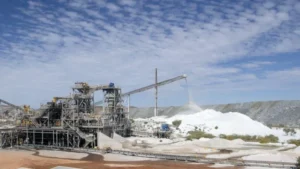Australian Prime Minister Anthony Albanese has vowed to invest A$1.2 billion (£580 million) into creating a strategic reserve for critical minerals if he wins the upcoming election, amid rising trade tensions.
The pledge follows China’s move to impose export restrictions on seven rare earth elements — vital components in advanced technologies like electric vehicles, fighter jets, and robotics.
While China’s controls target all countries, they are largely seen as a response to tariffs introduced by US President Donald Trump.
Albanese emphasized that Australia would focus on securing minerals crucial to its own national security and that of its allies, including rare earths.
But can his plan truly challenge China’s overwhelming dominance in the sector?

What Are Rare Earth Minerals and Why Are They Important?
Rare earths refer to a group of 17 elements known not for their scarcity, but for the difficulty in extracting and refining them.
Elements like samarium and terbium are essential in manufacturing technologies that are poised to shape the future — from electric vehicles to cutting-edge weapons systems.
Australian Prime Minister Anthony Albanese’s proposed strategic reserve would cover rare earths as well as other critical minerals in which Australia is already a major producer, including lithium and cobalt.
Although both China and Australia possess rare earth reserves, around 90% of global refining — the crucial process that renders these minerals usable — occurs in China, giving Beijing major leverage over global supply chains.
This dominance has alarmed Western governments.
Why Is China Restricting Rare Earth Exports?
Beijing has stated that its recent export restrictions are a response to the sweeping tariffs — currently at 145% — imposed by the Trump administration on Chinese goods entering the US.
However, analysts argue the bigger issue for Washington is its vulnerability when it comes to securing rare earth supplies, especially as tensions with Beijing escalate.
According to the US Geological Survey, China supplied approximately 75% of America’s rare earth imports between 2019 and 2022.
Philip Kirchlechner, director of Iron Ore Research in Perth, Australia, told the BBC that the US and EU had “dropped the ball” by underestimating the strategic importance of rare earths while China rapidly built a monopoly on refining.
“China has its foot on the blood vein… of US and European defence systems,” he said.
Highlighting the immediate impact, Tesla CEO Elon Musk recently noted that China’s halt on exporting rare earths critical for advanced magnets is already hampering the company’s efforts to develop humanoid robots — an early sign of the pressure Beijing can exert on American businesses.
Could Australia’s Plan Shift the Balance?
Under Albanese’s proposal, minerals stockpiled in the new reserve would be accessible to both domestic industries and international partners — a clear nod to allies such as the US and EU.
While Philip Kirchlechner welcomed the initiative as “long overdue,” he cautioned that it “won’t solve the problem” entirely.
The core challenge remains: even if Australia increases its stockpile of critical minerals, the refining of rare earths will still be overwhelmingly dominated by China.
Take lithium, for example — although not classified as a rare earth, it is essential for electric vehicle batteries and solar panels. Australia mines around 33% of the world’s lithium but refines and exports only a small fraction. In contrast, China mines just 23% yet refines 57% of the global supply, according to the International Energy Agency.
Australia is making strides to strengthen its refining capabilities through the Future Made in Australia initiative, which focuses on using its critical mineral wealth to drive the green transition.
Last year, Perth-based Arafura Rare Earths secured A$840 million in funding to establish the country’s first integrated rare earths mine and refinery. Additionally, Lynas Rare Earths opened Australia’s first rare earths processing facility in Western Australia in November.
Despite these advances, Australia is expected to remain reliant on Chinese refining at least until 2026, according to the Washington-based Center for Strategic and International Studies.
How Might the US and China React?
China has been actively seeking to exploit the instability triggered by Trump’s policies.
In a series of op-eds in Australian newspapers, Beijing’s ambassador to Canberra criticized Washington’s global trade approach and urged Australia to “join hands” with China — a suggestion Prime Minister Albanese quickly dismissed.
Meanwhile, Australia has highlighted its strong resource sector during negotiations with Trump, with some critical minerals even exempted from the 10% tariff he placed on most Australian imports.
However, analysts believe Albanese’s reserve plan is primarily designed to shield Australia and its allies from strategic vulnerabilities, particularly against China.
Alicia García-Herrero, chief Asia-Pacific economist at Natixis, told the BBC that Albanese’s proposal was “more sophisticated” than earlier strategies because it offers Australia the flexibility to release mineral reserves during times of economic strain.
If China enforces stricter export controls, Australia could step in to sell more minerals, helping to stabilize prices globally and diminish China’s market dominance.
Still, García-Herrero emphasized that Australia cannot fully replace China’s role.
“If Australia’s goal is to serve the West and become a more critical partner, there are vulnerabilities China could exploit — and the biggest one is still refining,” she said.